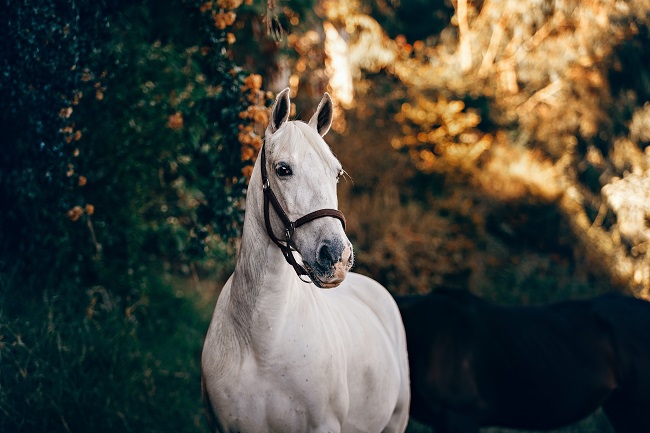
The placement and structure of your horse’s eyes is vastly different from a human’s. While we can easily wear glasses to correct poor vision, this isn’t possible for horses. Also, we are used to a clear field of vision in front of us. Horses, however, have amazing peripheral vision with two blind spots one directly in front of its nose extending to around four feet in front of it, and the other behind the tail, to about ten feet. When you consider the front blind spot, the abilities of jumping horses seem even more incredible. The horse loses sight of the obstacle when it is a few feet away and must rely totally on the rider to tell it when to jump.
Horses also are unable to focus their eyes the way humans and most animals can. Have you ever seen a horse raising and lowering its head as it looks at an object? It does that to adjust the focal length, moving their head until the object comes into focus on its retina. Also, since the horse’s field of vision doesn’t overlap—the right eye sees what’s happening on the right side of its body, and the left eye sees what is going on the left side of its body. It’s amazing that the horse isn’t confused all the time by two images that don’t match up at all.
The horse’s eyes also act something like a set of bifocal glasses that people use. If the horse lowers its head and looks up, gazing through the upper portion of the eye, it can focus on the horizon. However, if it needs to look at something closer, it will raise its head to regard the object through the lower portion of the eye, where it can focus more clearly. When you see a horse startled by a sudden movement just behind or beside it, this means that its peripheral vision has sighted the movement, but it has not yet had time to focus on it. Even when the horse is traveling a familiar path, such as to the stable or pasture, it can be startled by something as small as a paper blowing past.
Horses’ night vision is generally superior to that of humans. Horses have a reflective panel on the retina that helps to gather all available light at night. However, horses have a much lower sense of color than people. While they can distinguish green and blue, a horse’s sight is mostly in shades of gray.
Did You Know
The Gila monster hunts at night and if necessary can go without food for months, living on the fat stored in its tail.
Pigs are among the most intelligent of domesticated animals. Since they’re so adaptable and easy to train, many people keep them as pets.
The word Scalawag comes from the name of the undersized, temperamental ponies raised on Scalloway in the Shetland Islands.
An adult female fly lays 100 to 160 eggs at a time.
A school of piranhas can tear a victim to pieces in seconds.
Tree squirrels can leap 10 feet to reach one tree from another.
As a bat flies, it makes high pitched shrieks. The sound waves from these cries bounce off objects and echo back to the bat’s ears. From these echoes the bat can tell where objects are located.
Related Articles & Free Email Newsletter Sign Up
4 Annual Vaccinations Your Horse Needs to Receive
How to Catch a Horse That Runs from You


Comment here